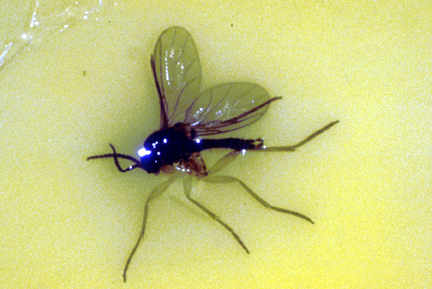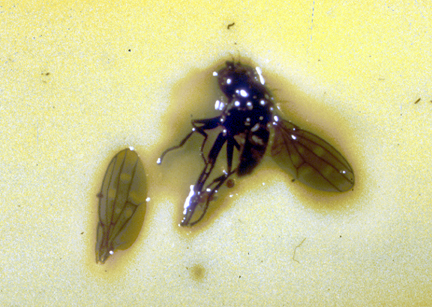Landscape & Ornamental
FUNGUS GNATS AND SHORE FLIES
Clifford S. Sadof, Extension Entomologist
If you want to view as pdf, click here
Fungus gnat and shore fly adults are commonly found hovering about the surface of greenhouse plants and potting media. Both fungus gnats and shore flies thrive in moist conditions, especially during propagation, plug production, and before plants develop well-established root systems. Fungus gnats are a more serious problem to greenhouse growers because they directly damage plants, while shore flies are primarily a nuisance. Fungus gnats can also damage plants when they transmit fungal diseases. Recognizing the difference between these two pests will help you develop a more effective pest management program.
DESCRIPTION, LIFE CYCLE AND DAMAGE
Fungus Gnats
Adults are small (1/8 inch long), slender, black or dark brown flies. Their two wings are delicate and clear, with a distinctive “Y” shaped vein in each wing. Antennae are longer than the head and many segmented. Legs are long and dangling, resembling a mosquito. Adults are weak fliers and are normally found flying or running over the growing medium surface.
Fungus gnat adult.
Larvae are whitish-clear, with a shiny black head capsule. The digestive system is often visible through its transparent body. Larvae grow to 1/4 inch long.
The two most common fungus gnats found in greenhouses are Bradysia coprophilia and Bradysia impatiens. Their life cycle consists of an egg, four larval stages, a pupa, and an adult. Females can lay between 100 to 200 small (less than 1/32 inch long) whitish eggs in the cracks and crevices of the growing medium in a five-day period. Fungus gnat females are highly attracted to growing media containing peat moss and pine bark.
Eggs hatch into white, transparent or slightly translucent, legless larvae that are approximately 1/4 inch long. Larvae can be found within the top 1 to 2 inches of the growing medium; however, they can also be found in the bottom and on the edge of pots. Fungus gnats take approximately 2 weeks at 72°F to develop into a pupa. After 4 to 7 days, adults emerge from the pupal skin. Adult fungus gnats generally live about 10 days.
Fungus gnat larvae damage plants by feeding on plant roots. They are especially destructive to seedlings and young plants, but can also damage mature plants if numbers are high. Larvae can tunnel into succulent stems at and below the growing medium surface. This tunneling collapses the stem causing the plant to wilt, or grow less vigorously. Larvae are capable of transmitting fungal pathogens such as Pythium, Thielaviopsis, and Fusarium. In addition, larval feeding creates wounds that allow secondary soil-borne pathogens to enter roots. Adult fungus gnats are also capable of transmitting fungal pathogens, including Botrytis. In addition to damaging plants, fungus gnat adults emerging from plants in wholesale or retail situations are considered a nuisance that can affect plant sales.
Shore Flies
Adults look very much like small houseflies. They are 1/8 inch long, and have black bodies and reddish eyes. They possess dark wings with five or more light-colored spots on each wing. Antennae are shorter than the head and the legs are small. Shore flies are stronger and faster fliers than fungus gnats.
Larvae are opaque yellowish-brown with no head capsule and grow to 1/4 inch in length. The most common species of shorefly found in greenhouses is Scatella stagnalis. Shore flies have a life cycle consisting of an egg, 3 larval stages, a pupa, and an adult. Females lay eggs in areas where algae accumulate, such as growing medium, benches, and greenhouse floors. A single female can lay between 300 to 500 eggs. Eggs hatch in two days into maggot-like larvae that are light tan. Larvae are found just under the top layer of growing medium, where they feed on algae. The body is located in the growing medium and the head in the algae. Larvae take 7 to 10 days to form pupae in the growing medium. Adults emerge in 4 to 5 days and live about 3 to 4 weeks.
Large numbers of shoreflies can reduce crop marketability. Generally, the adult and larval stages of shore flies feed on algae and fungi, not plant roots.
MANAGEMENT
Cultural Control
Inspect incoming plant material for adults flying around. If possible, place incoming plant material in a holding area with one or two sticky cards randomly distributed among the plants. Maintain plants in the holding area for approximately 5 days. Inspect sticky cards at the end of the five-day period. If fungus gnats and/or shore flies are present on the sticky cards apply an insecticide.
Shore fly adult.
Remove discarded plant material and used, or old growing media tominimize fungus gnat and shore fly problems. Piles of uncovered growing media and debris should never be allowed in the greenhouse because they provide suitable resting sites for fungus gnat and shore fly pupae.
Maintain a weed-free environment. Weeds should be eliminated from inside and outside the greenhouse, including areas underneath benches, behind vents, and in pots. Weeds underneath benches may create a moist environment suitable for fungus gnat and shore fly development. Maintain a 20-30-foot weed-free barrier around the greenhouse perimeter to prevent weed seed germination and entry of new weed seeds through unscreened vents and doors.
Control algae in pots, in propagation areas, on benches, and under benches because fungus gnats and shore flies breed in algae. Areas under benches can be treated with a disinfectant such as Green-Shield, Triathlon, ZeroTol, Physan 20, or chlorine bleach. Algae removal will greatly reduce shore fly populations.
Clean up all freestanding water on solid benches, on walks, and under benches. Be sure that cooling pad distribution tubes are not leaking. Avoid overwatering plants.
Scouting and Record-Keeping
Use systematic inspections and record keeping to identify the particular crops and parts of the greenhouse with pest problems. Monitor fungus gnat and shore fly infestations by counting adults attracted to yellow sticky cards. Place sticky cards 1 to 2 inches above the crop canopy or growing medium. Inspect yellow sticky cards weekly using a 10X-hand lens, and record the number of adults per sticky card. Expose and count just one side of a sticky card per week to save time and labor. To monitor for fungus gnat adults, place sticky cards horizontally on the growing medium surface or on the edge of flats or pots.
Scout for larval populations of fungus gnats by placing potato slices (1 inch diameter, 1/2 inch thick) on the growing medium surface. Potato slices should be removed after 48 hours. The larvae, which are attracted to the potato slices, can be seen adhering to the bottom surfaces when lifted from the growing medium.
Biological Control
Use beneficial nematodes and soil predatory mites as biological control options for fungus gnats. Beneficial nematodes effectively control fungus gnats, do not injure plants, are safe to greenhouse workers, and do not promote insecticide resistance. The most effective beneficial nematode for controlling fungus gnats is Steinernema feltiae (Nemasys, Entonem, and Scanmask). Proper application procedures will vary with the crop and production system. Application soon after fungus gnats are detected provides optimum control. Two or three applications throughout the crop cycle should keep fungus gnat populations low throughout a 10-12-week cropping period.
Another biological control agent is the soil-predatory mite, Hypoaspis miles. This mite completes its life cycle (egg to adult) in 7 to 11 days. It normally inhabits the top layers of the growing medium, where it feeds on fungus gnat larvae. For best efficiency introduce it at planting or just afterward.
Biological control of shore flies is more difficult, but involves the use of the soil-predatory mite, Hypoaspis miles. The mite attacks shore fly larvae and may control shore flies if there is no standing water. Shore flies can survive in standing water whereas H. miles cannot. Make releases as soon as shore flies are detected.
Other biological controls that are available commercially include the predatory mite, Statiolaelaps scimitus, the rove beetle Dalotia coriaria. Predatory hunter flies, Coenosia attenenuate, may come in on plant material.
Using Biological Control Effectively
- Consult Extension and biological control specialists, supplier catalogs, trade journals, and publications to obtain as much information as possible prior to starting a biological control program.
- Find a reliable biological control supplier, and be sure to order biological control agents at least 3 weeks before application. Release biological control agents upon delivery; delaying release reduces effectiveness.
- Start on a small scale. Don’t convert an entire operation to biological control until you have tested it and feel comfortable with using it.
- Release biological control agents before fungus gnat or shore fly populations reach damaging levels. Biological control is a preventative measure, not a reactive measure.
- Scout and record the number of fungus gnat and shore flies present before and after release of biological control agents in the greenhouse.
Chemical Control
Aim insecticide applications for fungus gnats and shore flies at either larvae or adults. The best long-term chemical control for fungus gnats and shore flies targets the larvae stages. Insecticidal drenches or growing medium surface sprays (“sprenches”) of Distance, Fulcrum or Adept are particularly effective against larvae. Certain insecticides may not affect eggs or pupae, and as such, repeated applications may be necessary. Insecticide applications directed only against the larval stages do not directly affect adults in the greenhouse.
Adults can be effectively controlled with labeled sprays or aerosols. The microbial insecticide Gnatrol (Bacillus thuringiensis var. israelensis) is a bacterium that controls the larvae of fungus gnats, but not shore flies. It is most effective when applied as a drench. For information on recommended insecticides for fungus gnats and shore flies refer to Table 1.
| Table 1. Insecticides Recommended for Fungus Gnat and Shore Fly Management. |
|---|
| Active Ingredient | Trade Name | REI* | Target | Insecticide Mode of Action (IRAC) |
|---|---|---|---|---|
| FUNGUS GNATS AND SHOREFLIES | ||||
| Acephate | Orthene | 24 | A | 1b |
| Azadirachtin | Azatin Ornazin |
4 12 |
L L |
UN |
| Bifenthrin | Talstar Attain |
12 12 |
A A |
3a |
| Cyfluthrin | Decathlon | 12 | A | 3a |
| Cyromazine | Citation | 12 | L | 17 |
| Diflubenzuron | Adapt | 12 | L | 15 |
| Pyriproxyfen | Distance, Fulcrum | 12 | L | 7c |
| FUNGUS GNATS ONLY | ||||
| Acetamiprid | TriStar | 12 | L | |
| Bacillus thuringiensis var. israelensis | Gnatrol | 4 | L | 11a |
| Chlorphenapyr | Pylon | 12 | L | 13 |
| Dinotefuran | Safari | 12 | L | 4a |
| Pyrethrin | Pyrethrum | 12 | A | 3a |
READ AND FOLLOW ALL LABEL INSTRUCTIONS. THIS INCLUDES DIRECTIONS FOR USE, PRECAUTIONARY STATEMENTS (HAZARDS TO HUMANS, DOMESTIC ANIMALS, AND ENDANGERED SPECIES), ENVIRONMENTAL HAZARDS, RATES OF APPLICATION, NUMBER OF APPLICATIONS, REENTRY INTERVALS, HARVEST RESTRICTIONS, STORAGE AND DISPOSAL, AND ANY SPECIFIC WARNINGS AND/OR PRECAUTIONS FOR SAFE HANDLING OF THE PESTICIDE.
October 2021

It is the policy of the Purdue University Cooperative Extension Service that all persons have equal opportunity and access to its educational programs, services, activities, and facilities without regard to race, religion, color, sex, age, national origin or ancestry, marital status, parental status, sexual orientation, disability or status as a veteran. Purdue University is an Affirmative Action institution. This material may be available in alternative formats.
This work is supported in part by Extension Implementation Grant 2017-70006-27140/ IND011460G4-1013877 from the USDA National Institute of Food and Agriculture.
1-888-EXT-INFO
www.extension.purdue.edu
Order or download materials from www.the-education-store.com




